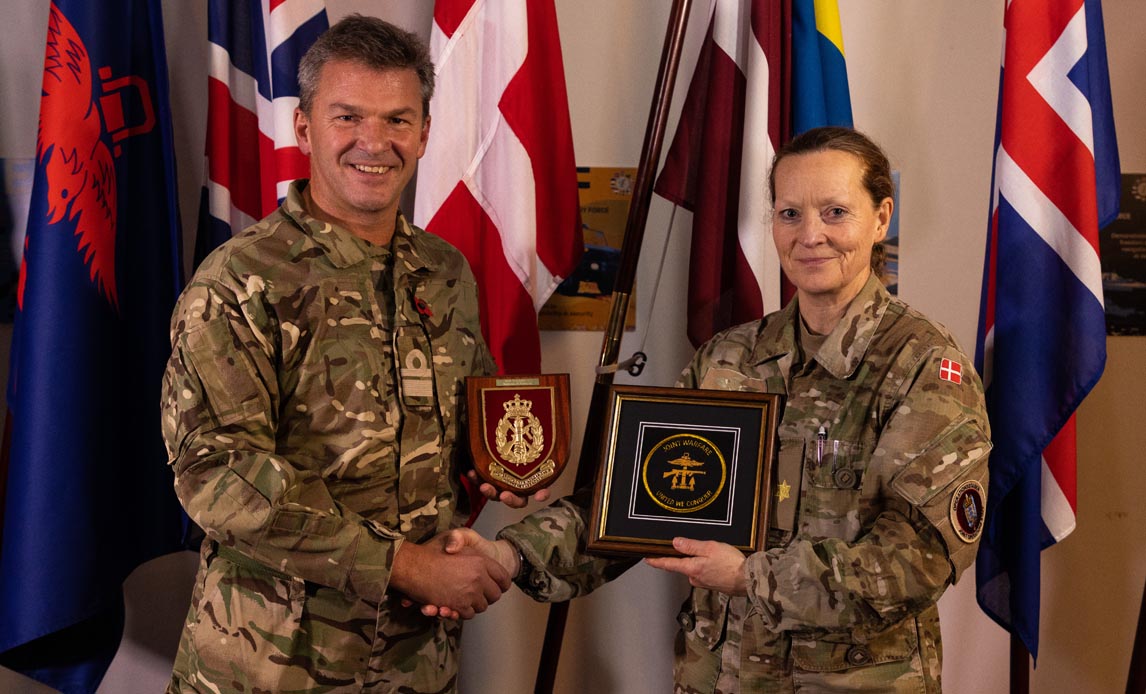The Danish Armed Forces train crisis management in Denmark's local region together with nine JEF countries
A British headquarters comprising 400 personnel and 65 officers and advisers from Denmark and the other JEF nations will take part in exercise Joint Protector in the Danish town of Nymindegab from 31 October to 12 November. They will train responses to current security challenges in the Baltic region, the North Atlantic and the area north of the Arctic Circle.

Flags of the 10 nations in the JEF, who are all participating in exercise Joint Protector in Nymindegab in Denmark. Photo: Rasmus Franck/Danish Armed Forces.
By the Danish Defense Command
Denmark hosts exercise Joint Protector, which is this year's most important JEF exercise. The Joint Expeditionary Forces (JEF) are led by the UK, and also include contingents from Sweden, Norway, Finland, Iceland, Estonia, Latvia, Lithuania, and the Netherlands.
The UK Standing Joint Force Headquarters (SJFHQ) will deploy to Nymindegab in West Jutland and form the framework for the exercise, which takes place from 31 October to 12 November. Denmark provides up to 20 staff officers for the exercise, the British provide 400 soldiers, and the other participating countries contribute with approx 50 personnel. Joint Protector is a staff exercise allowing participants to plan operations; so apart from the headquarters, no field units are involved in the exercise.
Deputy Chief of Operations Staff in the Danish Defense Command, Brigadier Jette Albinus, will be the Deputy Commander in the British Headquarters during Joint Protector. "The exercise is not built around a fictitious scenario. It is reflects the world as it is today. This means that even though it is an exercise, we gain some experience in relation to the possible development of the current situation and possible JEF courses of action. This makes it close to reality, and thus also increases the likelihood that what we practice and train is as realistic and useful as possible", she says.
A headquarters is characterized by being able to react, plan and issue orders quickly and around the clock. Time is organized in a fixed "battle rhythm" with meeting forums and boards that support the planning and execution of operations.
Due to the war in Ukraine and the tense security-policy situation in the Baltic area, it is very relevant for the Danish Defense Command's Operations Staff to train procedures in a headquarters. "I have high expectations for Joint Protector, because we ourselves are in the process of setting up the Armed Forces' Operational Headquarters. I am absolutely convinced that we can learn a lot from being part of a headquarters of this size and from all the input added by British and partner countries’ experiences. We can take back lessons learned to the Armed Forces' Operational Headquarters and process them", explains Brigadier Jette Albinus.
"An effective headquarters requires familiarity with headquarters' processes and, not least, knowing each other", she continues. For Jette Albinus herself, the exercise will be a reunion with colleagues with whom she worked when she was on the Higher Command and Staff Course in the UK. She sees it as an advantage that she knows some of the British officers. "It's no secret that when things escalate and you get tired, it is, among other things, the personal relationships that enable you to get the tasks done anyway", she says.
It is not just the participants at headquarters themselves who can learn from exercise Joint Protector. Hosting a foreign headquarters is an example of host nation support. "Denmark is expected in a crisis or war situation to be a country where extra forces transit and where forces can stay for shorter or longer periods. In that situation, one can easily imagine that headquarters of this size will come to Denmark. Joint Protector provides some experience of what it takes to support a headquarters", says Brigadier Jette Albinus. In this exercise, the Danish Armed Forces Estate Agency will provide accommodation and catering, for example, while the Army, in cooperation with the Home Guard, takes care of guard tasks.

Director Joint Warfare, Rear Admiral Andrew Betton and brigadier Jette Albinus. The Rear Admiral visited the exercise during Joint Protector. Photo: UK Armed Forces.
Exercise Joint Protector is a result of extensive planning. Last year JEF held a similar exercise in Sweden. The JEF complements NATO and focuses on security challenges in the Baltic region, the North Atlantic and the area north of the Arctic Circle.
Standing Joint Force Headquarters (SJFHQ)
Standing Joint Force Headquarters (SJFHQ) is the United Kingdom's deployable joint headquarters. SJFHQ is on 5-day readiness. SJFHQ has been given responsibility for the Joint Expeditionary Force (JEF) and Combined Joint Expeditionary Force (CJEF), both of which are concepts where the UK collaborates with international partners.
Danish Lieutenant Colonel Lars Bossen is Denmark's liaison officer in JEF and is stationed at SJFHQ. He says:
“For SJFHQ, it is extremely important to train with the JEF nations. Such exercises provide SJFHQ with invaluable experience and input for the further development of the JEF. Joint Protector provides both an opportunity to train SJFHQ's ability to deploy and establish a forward joint headquarters, and at the same time it allows the permanent staff and personnel contributions from the JEF nations to train the procedures essential to the effectiveness of the JEF”.